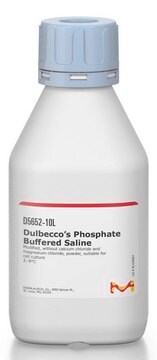56064C
Dulbecco′s Phosphate Buffered Saline
dry powder, DPBS Modified, without calcium, without magnesium, suitable for cell culture
Pharma Manufacturing
Synonym(s):
DPBS
Sign Into View Organizational & Contract Pricing
All Photos(1)
About This Item
Recommended Products
Quality Level
description
for research or for further manufacturing use
form
dry powder
technique(s)
cell culture | mammalian: suitable
cell culture | stem cell: suitable
shipped in
ambient
Looking for similar products? Visit Product Comparison Guide
Application
Dulbecco′s Phosphate Buffered Saline (DPBS) is intended for use in the maintenance of mammalian cells where a chemically defined balanced salt solution provides an environment that will maintain the structural and physiological integrity of cells in vitro. DPBS is commonly used in cell enumerations as a diluent, for rinsing cells and as a buffer in many chromatographic procedures. DPBS also is used to wash and resuspend cells during the dissociation process, where the presence of calcium and magnesium can inhibit trypsin activity. For this application, use DPBS Modified, which is formulated without calcium and magnesium salts.
Dulbecco′s phosphate buffered saline (DPBS) has been used in in vitro degradation studies of specimens.
Quantity
Formulated to contain 9.6 grams of powder per liter of medium.
supplement
Product No.
Description
Pricing
Storage Class Code
11 - Combustible Solids
WGK
WGK 1
Flash Point(F)
Not applicable
Flash Point(C)
Not applicable
Personal Protective Equipment
dust mask type N95 (US), Eyeshields, Gloves
Certificates of Analysis (COA)
Search for Certificates of Analysis (COA) by entering the products Lot/Batch Number. Lot and Batch Numbers can be found on a product’s label following the words ‘Lot’ or ‘Batch’.
Already Own This Product?
Find documentation for the products that you have recently purchased in the Document Library.
Customers Also Viewed
Effect of curing regime and maturation time on photopolymerisation and in vitro behavior of a polymeric light-cured calcium phosphate cement.
Barounian M H, et al.
Biointerface Research in Applied Chemistry, 6(3) (2016)
Fahimeh Shahabipour et al.
Journal of biomedical materials research. Part A, 108(8), 1596-1606 (2020-03-18)
The interaction between osteogenic and angiogenic cells through a coculturing system in biocompatible materials has been considered for successfully engineering vascularized bone tissue equivalents. In this study, we developed a hydrogel-blended scaffold consisted of gelatin methacryloyl (GelMA) and alginate enriched
Our team of scientists has experience in all areas of research including Life Science, Material Science, Chemical Synthesis, Chromatography, Analytical and many others.
Contact Technical Service




